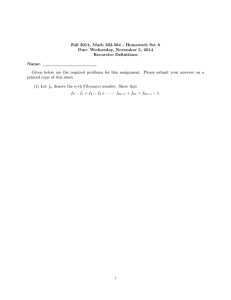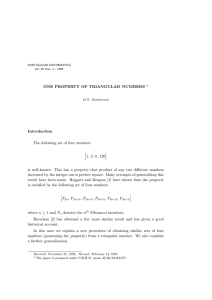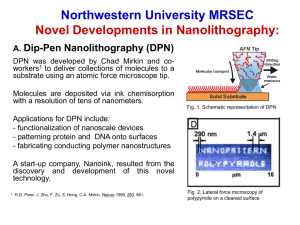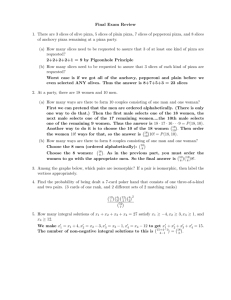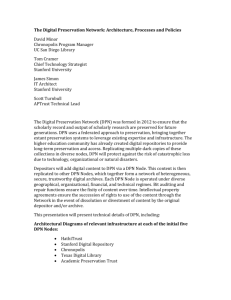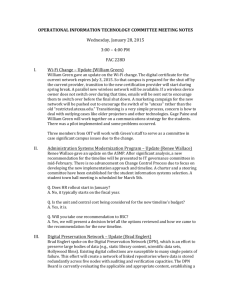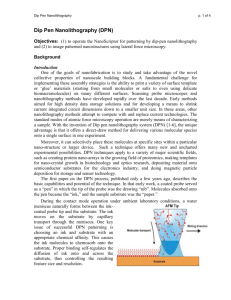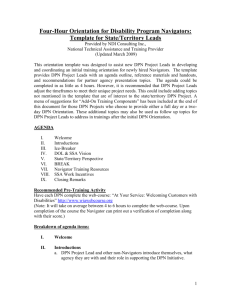by
advertisement
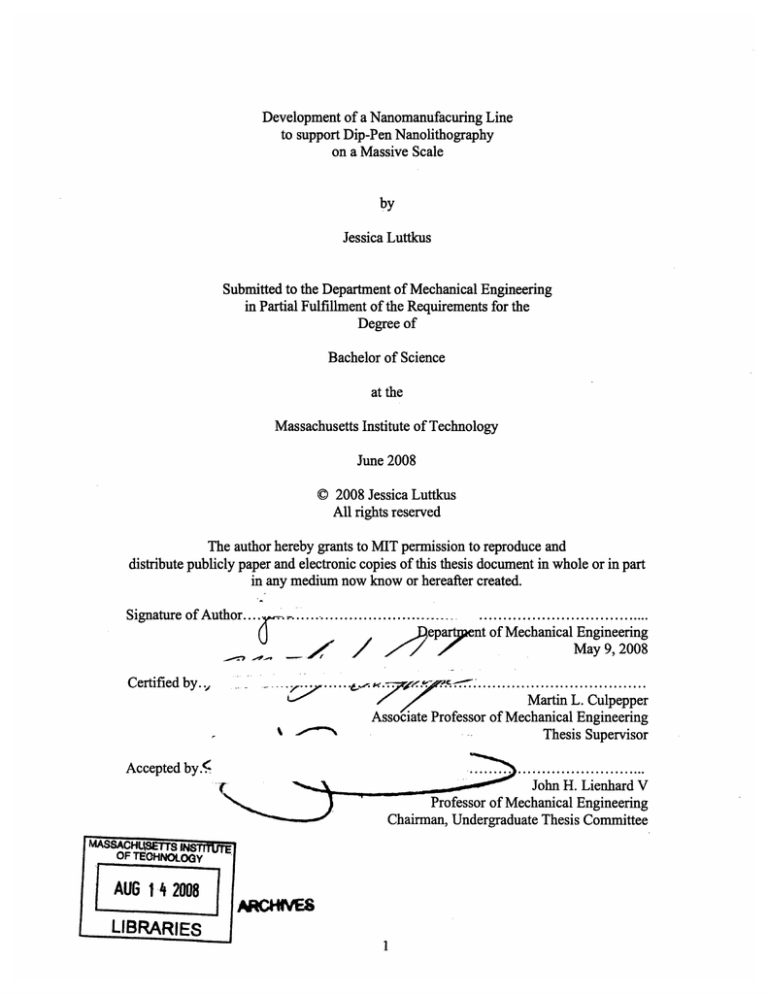
Development of a Nanomanufacuring Line to support Dip-Pen Nanolithography on a Massive Scale by Jessica Luttkus Submitted to the Department of Mechanical Engineering in Partial Fulfillment of the Requirements for the Degree of Bachelor of Science at the Massachusetts Institute of Technology June 2008 C 2008 Jessica Luttkus All rights reserved The author hereby grants to MIT permission to reproduce and distribute publicly paper and electronic copies of this thesis document in whole or in part in any medium now know or hereafter created. Signature of Author... ..... ........................................... of Mechanical Engineering " _epartPent . / May 9, 2008 Certified by.., Martin L. Culpepper Associate Professor of Mechanical Engineering .Thesis · Supervisor Accepted by.< John H. Lienhard V Professor of Mechanical Engineering Chairman, Undergraduate Thesis Committee OF TECHNOLOGY IAUG 1 2008 LIBRARIES AIBCHIV.ES Development of a Nanomanufacuring Line to support Dip-Pen Nanolithography on a Massive Scale by Jessica Luttkus Submitted to the Department of Mechanical Engineering on May 9, 2008 in Partial Fulfillment of the Requirements of the Degree of Bachelor of Science in Mechanical Engineering ABSTRACT A manufacturing line to support dip pen nanolithography on a massive scale is justified and described. Appropriate machines are evaluated based on key parameters such as cost, rate, and resolution. Methods for comparing lines are discussed, and solutions for lowest cost and fastest lines are provided. Thesis Supervisor: Martin L. Culpepper Title: Associate Professor of Mechanical Engineering Chapter 1 Introduction Purpose, Importance, Impact This purpose of this research was to create and optimize a nanomanufacturing line to support dip-pen nanolithography on a massive scale. The goal is to design a system in which a large number of dip pen nanolithographers can function in parallel. There exist many nanoscale machines which can aid DPN and from them the best must be selected to create a line of optimal cost, rate, and reliability. The creation of such a nanofactory is important for mass manufacturing on a nano scale. The machines needed to support DPN are costly and possess a wide range of performance and reliability characteristics. This complicates the design of a manufacturing line for low cost and high rate. The expense of the machines makes it impractical to increase overall throughput by just adding machines. Instead, the differences in cost and performance must be quantified, and then guidelines for dealing with those differences must be developed. Only after that can options for the line be compared based on their impact on final product cost. The results of this research will enable engineers to better understand the benefits and costs of designing DPN-enabled products. This will allow them to assess whether or not DPN is the right tool for their purposes. This work has the potential to enable breakthroughs in disease prevention and cure. DPN can be used in the manufacturing of bio and nano products in the medical industry [1]. The use of DPN on a massive scale will provide a means for mass modification of DNA, possibly fixing genetic problems even before they surface. There is currently no method available to do this. Fit with development of nanotechnology In recent years nanotechnology has seen tremendous growth. The growth has been fueled by advances in micromachining which enable the manufacture of extremely small parts [2]. Previously machines were simply incapable of creating quality parts on a nanoscale. Technology has now advanced to the point where this is no longer a concern. The industry has also grown broadly in the range of applications it touches [2]. As prices fall, nanomachining has been gaining popularity in a diverse array of fields, from silicon chip manufacturing to biotechnology and medicine. The scope of nanomanufacturing can only be expected to expand as costs continue to decrease and technology continues to advance. The full potential of nanomanufacturing cannot be realized until a method is developed to integrate the appropriate machines into a complete and cohesive production line. Nanoproduction lines must be created to build nanofactories for the mass production of nanodevices. This scaling up is necessary to decrease the overall costs of the final products and make them accessible to a broader audience. The development of nanofactories will thus help nanotechnology to reach its full potential in the creation of products for the global marketplace. Until now, no substantive research on the development of nanomanufacturing lines has been completed. As discussed above, such research is critical to the continued development of this industry. While the idea of macroscale production lines is relatively old and essentially taken for granted in modern manufacturing factories, the same logic has not yet been applied to manufacturing on the nanoscale. Use over the past decades has proven the benefits of production line improvements through careful study. There are many factors to consider in the creation of any manufacturing line. For nanomanufacturing, critical parameters are rate, cost, and reliability. While those three factors do not provide a complete picture of the pros and cons of a particular line, they are a good place to start evaluating nanomachines to develop a manufacturing line for the first time. A knowledge of nanomanufacturing line creation is needed for further development of DPN. DPN can be refined to produce at high rates and low costs, however improvements are not useful unless it is understood how they will affect the final product. A DPN machine cannot function alone, and unless the machines needed to support it can keep pace with DPN improvements, no benefit will be passed on to the final product. Additionally, before manufacturers invest in DPN devices they want to understand how DPN will affect their products. A full picture of the DPN process, including pre- and post-DPN sample work, is needed to specify and prove the specific benefits of DPN. To complete the picture of DPN use for any type of large-scale manufacturing, it is critical to understand which machines are needed to support it and how they will interact with the DPN and with each other. In this paper, chapter 2 describes the technique and applications of dip pen nanolithography, in addition to discussing the development of technology to facilitate DPN on a massive scale. Chapter 3 provides an overview of atomic force microscopy, including what it is, how it is used, and how it is important to this research. Chapters 4, 5, and 6 provide the same information on scanning tunneling microscopy, focused ion beam systems, and electron beam lithography, respectively. Chapter 7 discuses the key considerations for optimizing the manufacturing line and describes variations for machine arrangement within the line. Chapter 8 gives methods for finding the lowest cost and fastest lines and describes the optimal lines for both goals. Chapter 9 describes the optimal line for massive DPN and suggests areas for future research. Chapter 2 Dip Pen Nanolithography This chapter describes the technique and applications of dip pen nanolithography. Current advances and the development of technology to facilitate DPN on a massive scale are also discussed. Current Machine Dip pen nanolithography is a technique for modifying samples on a nano scale. It uses an AFM-like probe to deposit molecules on the surface of a sample, creating many types of patterns [3]. Professor Martin Culpepper and Mr. Christopher DiBiasio are currently working on a meso-scale Hex-Flex nanopositioner that will allow DPN to be used in mass manufacturing. The nanopositioner will provide six-axis sensing, a critical component for DPN to be used on a large scale [4]. The nanopositioner currently being developed is on a meso-scale for several reasons [4]. As a smaller machine, costs of the mechanical elements in the system are lower. Also, it will have a higher natural frequency, which may allow for higher bandwidths. Finally, temperature errors will be lower since a smaller amount of material will cause less expansion and contraction under temperature variation. In a large-scale DPN context, Hex-Flex nanopositioners would be used to manipulate arrays of tens of thousands of probes executing DPN [4]. To execute DPN on a massive scale it is necessary to coordinate many probes simultaneously. Nanopositioners would also be needed to move the samples during the procedure. Sixaxis sensing is crucial in this process to prevent misalignment of the probes relative to each other and the sample. Culpepper's team has achieved notably small errors in a range of 10s to 100s of nanometers [4]. These errors include thermal effects, vibration, electrical interference, and fabrication errors. Efforts are currently underway to develop an appropriate control system such that nanometer and potentially sub-nanometer resolution can be achieved. Advantages of Dip Pen Nanolithography The DPN process is unique because it allows the user to write directly on the surface of a sample [1]. It can create original patterns at high resolutions on many materials such as metals and semiconductors. The deposited "ink" flows onto the substrate in much the same way as ink flows from a pen. DPN can be completed with many molecular and biomolecular inks [1]. DPN is a single-step process and does not require the use of resists. Because it combines imaging and writing in the same device, multiple patterns can be aligned on the same substrate at the same time. These characteristics and more have made it an integral part of the study and fabrication of objects on the sub-100nm length scale. Uses of Dip Pen Nanolithography Current uses of DPN include surface science investigations and the creation of technologically useful nanostructures [1]. Methods of writing on an even greater variety of samples, including semiconductors, insulators, and metals, are currently under development. In addition, efforts are underway to expand the repertoire of usable inks to biological polymers and conducting organic macromolecules. DPN has many practical applications [1]. It has been successfully used to construct nanoarrays of proteins with 100 nm features and to investigate biological interactions within a nanostructure. It can be used to deposit proteins directly, saving time and reducing complexity while allowing the fabrication of arrays with multiple proteins. The semiconductor industry uses DPN to create nanoscale conducting polymer patterns on semiconductor surfaces. These are just a few examples of DPN applications, and the number continues to grow as more uses for DPN are discovered. Chapter 3 Atomic Force Microscopy This chapter provides an overview of atomic force microscopy, including what it is, how it is used, and how it relates to DPN. It concludes with a discussion of possible AFMs to include in a DPN manufacturing line. Description of Atomic Force Microscopy Atomic force microscopes (AFMs) use a probe in close proximity to a sample to measure local properties such as height, optical absorption, or magnetism [5]. Measuring a particular property over a sample area allows the microscope to acquire an image of that area. Since probes are used instead of lenses as in traditional microscopes, resolution is limited by probe size rather than diffraction. Up to atomic-level resolution may be achieved as AFM includes of sensitive detection using optical levers, flexible cantilevers, sharp probe tips, high-resolution tip-sample positioning, and force feedback. AFM is so named because it collects information on the sample by measuring attractive or repulsive forces between the probe and the sample [5]. It may be used in one of two modes: contact or non-contact. In contact mode, the probe lightly touches the sample resultant vertical deflection is measured as the probe is moved across the sample surface. In non-contact mode the tip oscillates above the sample rather than touching it, and attractive rather repulsive forces are measured. There is also a third mode, tapping, which combines the advantages of contact and non-contact imaging. In tapping mode, the tip oscillates widely above the sample, touching the surface briefly in each cycle. Tapping mode is slower, however it offers resolution similar to contact mode while applying only modest forces to the sample. Uses of Atomic Force Microscopy Many fields have benefited from the use of AFM. It has been used to image polymeric materials, semiconductors, DNA, single proteins, and living cells [5]. It is frequently used to evaluate the surface quality of products such as contact lenses, optical components, and semiconductor wafers after they undergo manufacturing processes. The main problem with using AFM on soft biological structures is resolution [5]. Resolution depends directly on tip sharpness, however sharp tips can damage a soft sample. The tip itself may also be damaged as a result of the stresses exerted on it during scanning. These problems can be alleviated by practicing AFM in a liquid environment rather than air, however several efforts are also underway to develop sharper tips that will not adversely affect the sample during the course of scanning. Use ofAtomic Force Microscopes with Dip Pen Nanolithography When modifying samples with DPN, it is necessary to analyze them before and after they undergo DPN. The pre-DPN scanning is necessary to identify landmarks on the surface so the DPN writing can be oriented as desired. Post-DPN scanning is required to check the DPN writing for errors before letting a sample continue through the manufacturing process. These checks are especially important in the context of a massive manufacturing line to avoid outputting samples with multiple errors that cannot be linked to any specific machine. For example, when modifying DNA, samples must first be scanned to determine DNA orientation before sending them to a DPN. AFM thus has the potential to be a critical part of a massive DPN manufacturing line. Atomic Force Microscopes evaluated Information was collected on several AFMs for comparison against each other and other potential scanning tools. Roughly fourteen different machines were evaluated, and from those three were selected as the best potential matches. They were selected on more qualitative measures, such as helpfulness and knowledge of the company salesperson and the machine's adaptability to the DPN process, particularly working with DNA. Key parameters for the three machines are summarized in Table 1. In this and following tables, rate refers to the length of time a machine would need to scan a five micron by five micron square of surface. Table 1: Cost, rate, and resolution data for three primary AFMs considered Machine Cost Rate Resolution Park XE-100 [6] $95,000 10-15 sec 10 nm AIST [7] $100,000-140,000 3 sec 2 nm Asylum Research [8] $185,000 2-8 sec 6 nm Chapter 4 Scanning Tunneling Microscopy This chapter provides an overview of scanning tunneling microscopy, including what it is, how it is used, and how it relates to DPN. It concludes with a discussion of possible STMs to include in a DPN manufacturing line. Description of Scanning Tunneling Microscopy Scanning Tunneling Microscopes (STMs) image samples by detecting differences in electron density on the surface [9]. The microscope has a tip that is placed close to the sample surface, leaving a gap of roughly 1 nanometer. A small voltage is applied to tunnel electrons between sample and tip. Electron density varies with atom position so the tunneling current changes as the tip is scanned across the sample. The changes in current can be used to map the surface of the sample at atomic resolution. Because other factors may affect tip-sample interaction, STM is not free from errors [10]. Investigations are currently underway to better understand the unique tipsample dynamics. Imaging metals can be difficult with STM because their surfaces appear smooth to the machine. Thus to achieve atomic resolution the tip must be kept extremely close to the sample surface (within 1/100 of an atomic diameter). This requires the STM to be quite rigid and free from environmental vibrations if quality images are to be acquired. Uses of Scanning Tunneling Microscopy STM is used in many applications, including semiconductors, superconductors, microelectronics, biology, and chemistry [11]. In the semiconductor industry, STMs are used to look at material deposited on silicon samples. STMs are also used to study chemical systems and processes on surfaces. Biologists use STM for its atomic resolution imaging of single molecules on surfaces. STM has been used to map DNA and globular macromolecules, and new applications continue to present themselves. Scanning Tunneling Microscopy and Dip Pen Nanolithography As discussed above, it is crucial to scan samples before and after they undergo DPN. STM is yet another way of doing this. It can be used to identify sample orientation and artifacts before DPN, as well as check the modifications after DPN. It can be less damaging than AFM to the sample, particularly soft DNA, as surface contact is not necessary to achieve high resolution. Scanning Tunneling Microscopesevaluated Most AFMs can also be used for STM, so the process of finding machines was similar to that discussed previously. While some machines appeared worthwhile in both uses, others seemed more valuable for only AFM or STM. Accordingly, two STMs were identified for further evaluation out of the pool originally considered. They were selected based on the knowledge of the salesperson and potential for use with DPN. Key parameters for each are summarized in Table 2. Table 2: Cost, rate, and resolution data for two primary STMs considered Machine Cost Rate Resolution Park XE-100 [6] $105,000 10-15 sec 10 nm Nanoscience [12] $93,900 20 sec 0.15-1.7 nm Chapter 5 Focused Ion Beams This chapter provides an overview of focused ion beam systems, including what they are, how they are used, and how they relate to DPN. It concludes with a discussion of possible FIBs to include in a DPN manufacturing line. Description of Focused Ion Beams Focused ion beams (FIBs) modify samples by scanning areas with gallium ions [13]. The ions generated may be collected to create an image of the sample surface at around 5-nanometer resolution [14]. FIB is also more commonly used to mill small holes in samples at the sub-micron scale. Resulting surface features are clean as they are etched by the gallium ions. With the introduction of gases or an organic gas compound, different materials can be etched at different rates or materials can be deposited on the sample. An advantage of FIB over scanning electron microscopes (SEMs) is that it can be used on non-conductive surfaces [14]. An electron flood gun can be used to neutralize charges and the image is then obtained with positive secondary ions. This eliminates the need for a conducting surface coating to image or mill a non-conductive sample. FIB can also be combined with SEM in a "dual beam" system [15]. This allows site-specific material removal by the FIB and nondestructive imaging by the SEM. Dual beam systems are a relatively new advance and are quickly gaining popularity over single-beam FIB machines. Uses of Focused Ion Beams FIB is widely used in the semiconductor industry. It provides cross-sectional imaging through layer structures, modification of electrical routing, failure analysis, preparation for physico-chemical analysis, preparation for transmission electron microscopy, micro-machining, and mask repair [13]. It has also seen growing use in materials science. It is used to prepare difficult materials for transmission electron microscopy, measure crack growth and aspect ration during stress corrosion cracking, and in the adhesion of polymer coatings [14]. FIB's precision material removal makes it an attractive choice for work in many fields. Use of Focused Ion Beam with Dip Pen Nanolithography FIB would be used in conjunction with DPN to modify samples. After being written on in the DPN stage of the manufacturing line, samples would be etched by FIBs. While FIBs are not critical to the functioning of DPN on a massive scale, it is likely that they would be needed at some point in the process of manufacturing the sample. They are for that reason included in this discussion, as it is worthwhile to consider their potential impact on a manufacturing line. Focused Ion Beam evaluation The pool of FIB manufacturers is not nearly as large as that of AFM/STM manufacturers, so FIB options were significantly more limited. Four machines were considered, and from those two were selected as the most promising candidates for inclusion with the DPN based on the helpfulness of salespeople and availability of critical information. Key parameters for each are summarized in Table 3. Table 3: Cost, rate, and resolution data for two primary FIBs considered Machine Cost Rate Resolution Hitachi FB-2100 [16] $500-$900K 80 sec 7 nm Hitachi NB-5000 [16] $1.2-$1.8M 60 sec 7 nm Chapter 6 Electron Beam Lithography This chapter provides an overview of electron beam lithography, including what it is, how it is used, and how it relates to DPN. It concludes with a discussion of possible EBLs to include in a DPN manufacturing line. Description of Electron Beam Lithography Electron beam lithography (EBL) was developed to create fine patterns for integrated circuits for the electronics industry [17]. In EBL, a beam of electrons scans a surface covered with a resist film sensitive to electrons. This leaves a pattern of high resolution on the film. The resist may be positive or negative, meaning that either written-upon regions or unwritten-upon regions are removed. EBL represents a substantial improvement over optical lithography, which is limited by the wavelength of light used for exposure [18]. The wavelength of the electron beam is so small that lithographic resolution is not determined by diffraction. Instead, resolution is limited by electron scattering in the resist and abnormalities in its electron optics. EBL also offers greater flexibility for design change as no mask is required [19]. It offers more options for substrate size as well. Some disadvantages are its low throughput and need for dedicated alignment targets. Uses of Electron Beam Lithography EBL is used in a variety of applications. There is particular growth in its use with non-silicon substrates and nano-electromechanical systems [19]. Some examples of current EBL use are cryo-electric devices, opto-electronic devices, quantum structures, transport mechanism studies of semiconductor/superconductor interfaces, microsystem techniques, and optical devices [17]. It is also crucial to current research efforts in the nanopatterning of magnetic thin films, the fabrication of masks for x-ray interference lithography, and the generation of x-ray optical components. Electron Beam Lithographyand Dip Pen Nanolithography As with FIB, EBL is not crucial to the use of DPN on a massive scale. It is included here though because of the high probability that it will be used in conjunction with DPN. Of particular importance would be the use of EBL to remove material according to a pattern deposited with DPN. It is therefore worthwhile to consider its effects in the development of a nanomanufacturing line to support DPN. Electron Beam Lithographerevaluation There are far fewer EBL manufacturers than AFM/STM manufacturer, so the selection of machines from which to choose was significantly smaller. Two were investigated in detail, but one was priced much lower and had more information available so it is presented here alone. The important characteristics to consider when adding it to a manufacturing line are displayed in Table 4. Table 4: Cost, rate, and resolution data for the primary EBL considered Chapter 7 Optimization Process This chapter discuses the key considerations for optimizing the manufacturing line and describes variations for machine arrangement within the line. Factors consideredin optimization As with any macro-scale manufacturing line, the key parameters to consider are cost, rate, and reliability. It is desired to create the fastest line at the lowest cost while maintaining high reliability. An additional consideration when operating on the nanoscale is resolution, as the resolution of the final product will be limited by the resolution of each machine. Cost is a key consideration in the development of a nanomanufacturing line because all machines required are expensive, presenting an immediate hurdle for the creation of a nanofactory. The lower the initial capital costs, the easier it will be for researchers and designers alike to create nanomanufacturing lines to fit their needs. For DPN to be widely used on a massive scale, these costs must be within reach. In particular for the case of nanoproducts, be they silicon chips or improved DNA, it is crucial to offer the product at low cost for it to be accepted in the market. If nanoengineered DNA is too expensive to obtain, it will not be used and its possible benefits will never be realized. The cheaper the production machines are, the cheaper their products can be. Thus even if nanoproducts are priced so that customers bear more of the machine expense than manufacturers, the industry will not be sustainable because there will be limited demand for such expensive products. It is critical to find cost-effective machine for integration into the line to ensure acceptance by manufacturers and their customers. In addition to cost, rate will have a strong impact of the success of this nanomanufacturing line. Rate is closely related to cost, as an expensive machine may be worth the price if it produces at a significantly higher rate. Essentially, machines must be able to produce at a rate to justify their cost. The overall rate of the line must also be such that the overall cost is justified. The benefits of an extremely fast, expensive machine will not be realized if the rest of the line is not set up to match that high rate. The line must also produce at a rate that is satisfactory to customers. They will want their products regularly, and will demand enough of them in a given time to satisfy their needs. If the line cannot produce fast enough, its continued operation will not be feasible as it will have no customers. Rate is thus an important factor to consider from several perspectives. Reliability of each machine is important for the viability of the whole nanomanufacturing line. The above considerations of cost and rate will be irrelevant if a machine cannot be depended up to work well. The risks of an undependable machine can be ameliorated by including others with it in series or parallel, however it is a very expensive fix given the prices of these machines. Regardless of how it is handled, the reliability of a machine must be taken into account when considering it for inclusion in the manufacturing line. Finally resolution is crucial for nanoscale applications. The machines in line with a DPN must match its resolution to be effective in generating products. For example, if the DPN is to be used to modify DNA, the microscopes scanning samples before and after they undergo DPN must be capable of registering features of that size. If resolutions are not appropriately small, the range of products that can be produced will be severely limited. As a basis for comparison, Table 5 lists the average values of these parameters for the machines discussed above. Table 5: Summary of average cost, rate, and resolution for AFMs, STMs, FIBs, and EBLs considered Machine Cost Rate Resolution AFM [6,7,8] $114,000 7 sec 2 nm STM [6,12] $102,000 12 sec 1 nm FIB [16] $1,100,000 90 sec 7 nm EBL [20] $1,500,000 75 sec 8 nm Parameters varied In the development of a manufacturing line the number and arrangement of machines can be varied. The machines can be arranged in series or in parallel. A parallel arrangement puts several machines together so that there is increased capacity for items going through. This is especially useful if one machine is slower that the rest so that its rate does not limit the rate of the entire line. It also provides some protection against machine failure because the line does not have to stop completely if one machine goes down. A series arrangement simply puts the machines in line one after another. It is a lower cost option and reduces the number of items in production at any one time. The two arrangements are depicted below in Figure 1. I~··-I I··llll·CII~I IXI·-l XILIIX-- I-~ ----- I ! N / 4, Parallel Series Figure 1: Schematic of parallel and series manufacturing lines Chapter 8 Optimal Lines This chapter gives methods for finding the lowest cost and fastest lines and describes the optimal lines for both goals. Lowest Cost Line The lowest cost line includes only the essential accessories to the DPN. The only strict requirements are machines to scan samples before and after DPN. This can be accomplished by an AFM or STM. Another important factor to consider is machine reliability, however reliability characteristics for the machines considered were unavailable. Thus machines were evaluated based on cost alone. The lowest cost line is the one which minimizes total cost in equation 1: Total cost = E (machine cost)i for all i in manufacturing line. (1) Because total cost is directly related to machine cost, it may be minimized by minimizing machine cost. Thus the lowest cost machine that fulfills the requirements, Park Systems XE-100 AFM, was selected. Total cost may also be minimized by minimizing the number of machines in the line. The minimum number of additional machines is two, one before and one after the DPN, an arrangement depicted below in Figure 2. This line provides the necessary pre-DPN sample orientation and artifact identification, as well as the post-DPN check, at a cost of $190,000. Figure 2: Diagram of lowest cost line Fastest Line The total time to process a sample in the line is found using equation 2: Total time = I (machine processing time)i for all i in manufacturing line (2) The fastest line is the one which minimizes total time. Total time is directly related to the speed of each machine, so total time will be minimized when each machine's processing time is minimized. Thus the machine with the lowest processing time, the AIST AFM, was selected. Total time may also be minimized by minimizing the number of machines in the line. The minimum number of additional machines is two, one before and one after the DPN, an arrangement depicted in Figure 3. The total time for this line is 6 seconds plus DPN processing time. Figure 3: Diagram of fastest line An infinitely low processing time could be achieved by adding more AFMs and DPNs in parallel, essentially creating hundreds of lines rather than one. The limiting factor in such a scenario is the cost of all the machines. Chapter 9 Conclusion This chapter describes the optimal line for massive DPN and suggests areas for future research. Summary The work presented here is a crucial first step in the development of nanomanufacturing lines. While not exhaustive, it offers a perspective on how different machines can be evaluated and which parameters are most important in the creation of a line. These results can be applied to the creation of any nanomanufactturing line, but they are of special relevance to DPN. As DPN use continues to grow, it will become necessary to use it on a massive scale. The scaling up of DPN will require appropriate supporting machines, and metrics for evaluating such machines are presented above. These results will allow the creation of large-scale DPN manufacturing lines, with the goal of modifying DNA for disease prevention and cure. Optimal Line The optimal manufacturing line to support DPN on a massive scale is the fastest line identified above. It is the fastest option, and although not the cheapest, it offers superior resolution in addition to speed to justify its cost. If the addition of FIB were considered, the optimal choice would be the Hitachi FB2100. It is cheaper than the other Hitachi machine and offers the same resolution. The selection of an EBL is even more straightforward, as only the JEOL JBX-5500 met initial requirements. The locations of a FIB and EBL in the optimal line are variable, but a possible line is shown below in Figure 4. There must be an AFM or STM between each step of the process to check for errors. Figure 4: Diagram of optimal nanomanufacturing line Directions for future research The first step for further research is to determine the manufacturing specifications of massive DPN. As the machine is currently in development, one cannot say for sure what its rate and cost will be. When selecting surrounding machines, it is helpful to know the rate of the machine they will be supporting. Not only is this necessary to determine the best configuration of machines, for instance the extent to series arrangement is needed, but it also may narrow the group of machines that are costeffective to put in line with the DPN. Once all parameters of the DPN are known, a more significant investigation into massive DPN manufacturing lines can be completed. It would also be worthwhile to investigate more choices for each machine. While several options for AFM and STM were considered, there are still many makers of such machines who were not contacted for technical specifications. Even more important is further research into FIBs and EBLs if it is determined that they will be needed in the nanomanufacturing line. Only a few options were investigated, and a larger pool from which to choose would likely yield even more desirable candidates. The results of this research can be applied to the creation of other nanomanufacturing lines not involving DPN. One relevant point is the importance of scanning devices to analyze samples before and after each separate process. In this case it was the AFM or STM in between the DPN, FIB, and EBL for example. As nanomanufacturing lines are created the demand for these types of microscopes will certainly grow, as will pressure to improve performance. Since they are such a critical part of the line it will be important for them to keep pace with the machines they support by becoming ever faster, cheaper, and more reliable. References [1] DPN Subgroup, http://chemgroups.northwestem.edu/mirkingroup/dpn.htm, May 2008. [2] Nanotechwire.com "Rapid growth of nanotechnology." 7/19/04 [3] Barsotti, R. and Stellacci, F., Dip Pen Nanolithography, Supramolecular Nano Materials Group at MIT, http://mit.edu/dmse/sunmag/res dippin.shtml, May 2008. [4] DiBiasio, C. M., Culpepper, M. L., and Whitson, M. J., "Design of a Meso-scale Sixaxis Nanopositioner with Integrated Position Sensing", ISNM, pp. 1-2. [5] Baselt, D. "The tip-sample interaction in atomic force microscopy and its implications for biological spplications", Ph.D. thesis at California Institute of Technology, 1993. [6] Faddis, D., Park Systems, email, November 15, 2007. [7] Krayev, A., AIST-NT Inc., email, November 30, 2007. [8] Fulerer, R., Asylum Research, email, November 29, 2007. [9] Bedrossian, P., "Scaning Tunneling Microscopy: Opening a New Era of Materials Engineering," https://www.llnl.gov/str/Scan.html, May 2008. [10] Schmid, M., TU Wien, "The Scanning Tunneling Microscope: What it is and how it works," http://www.iap.tuwien.ac.at/www/surface/STM Gallery/stm schematic.html, May 2008. [11] Jones, C., Mulloy, B., and Thomas, A.H., Microscopy, Optical Spectorscopy, and Macroscopic Techniques. Humana Press, 1994. [12] Cain, R., Nanoscience, email, November 29, 2007. [13] Bender, H., European FIB Users Group, "Introduction Focused Ion Beam," http://www.imec.be/efug/EFUG10.html, May 2008. [14] "Introduction: Focused Ion Beam Systems," Fibics Inc., http://www.fibics.com/FIBBasics.html, May 2008. [15] Giannuzzi, L.A., and Stevie, F.A., Introduction to Focused Ion Beams. Springer, 2005. [16] Jarausch, K., Hitachi High Technologies America, email, December 3, 2007. [17] Celusco, E., and Bennici, E., "Electron Beam Lithography (EBL) - Overview of Systems, Processes and Potential Industry Applications," Materials and Microsystems Laboratory of the Polytechnic of Turin and the National Institute for Physics of Matter, 2008. [18] "Electron Beam Lithography," http://www.siliconfareast.com/lith electron.htm, May 2008. [19] "Electron Beam Lithography," http://www.imec.be/wwwinter/mediacenter/en/SR2005/html/142298.html, May 2008. [20] Hamilton, S., JEOL USA, Inc., email, November 20, 2007.
